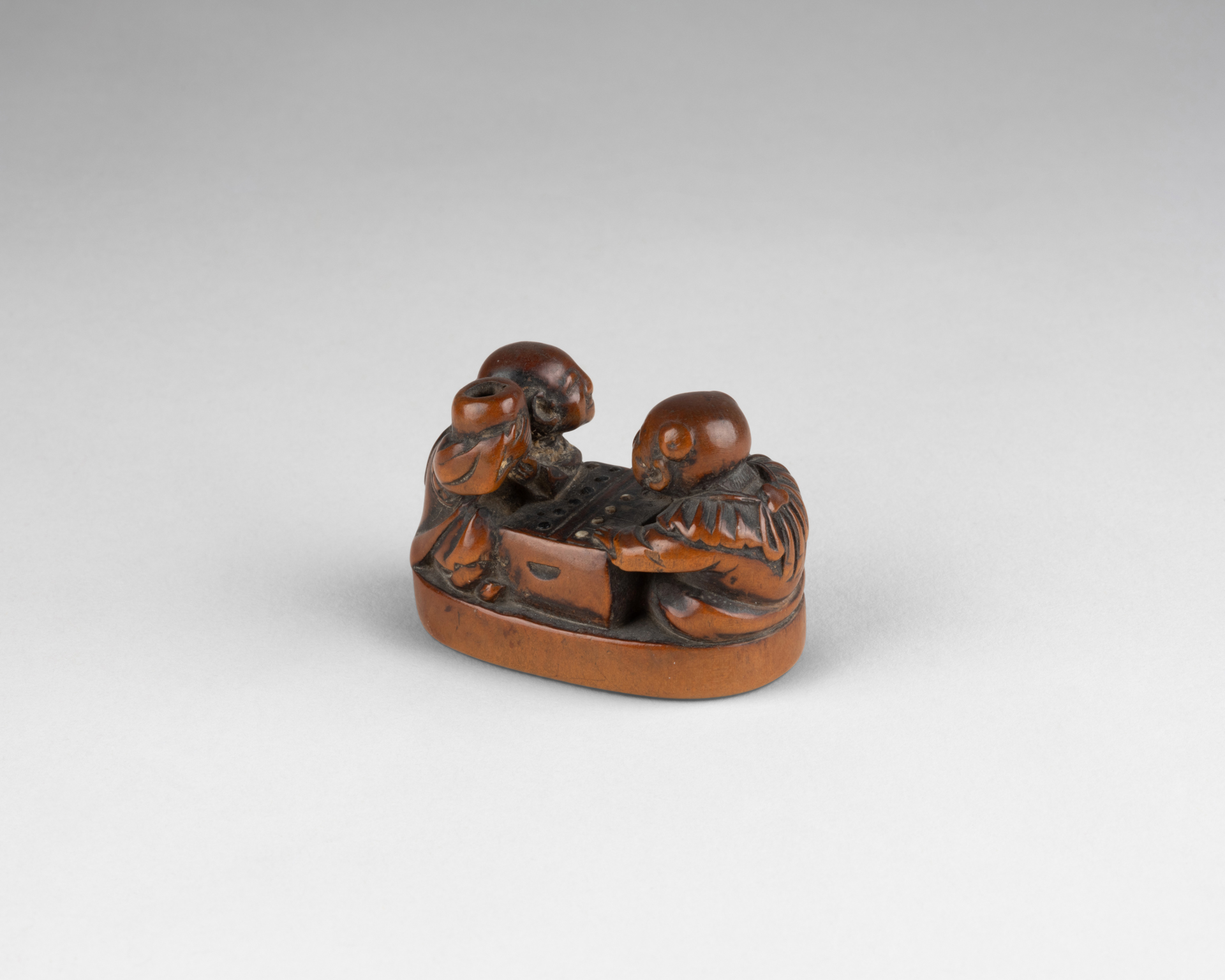Netsuke – Ravissant daim couché
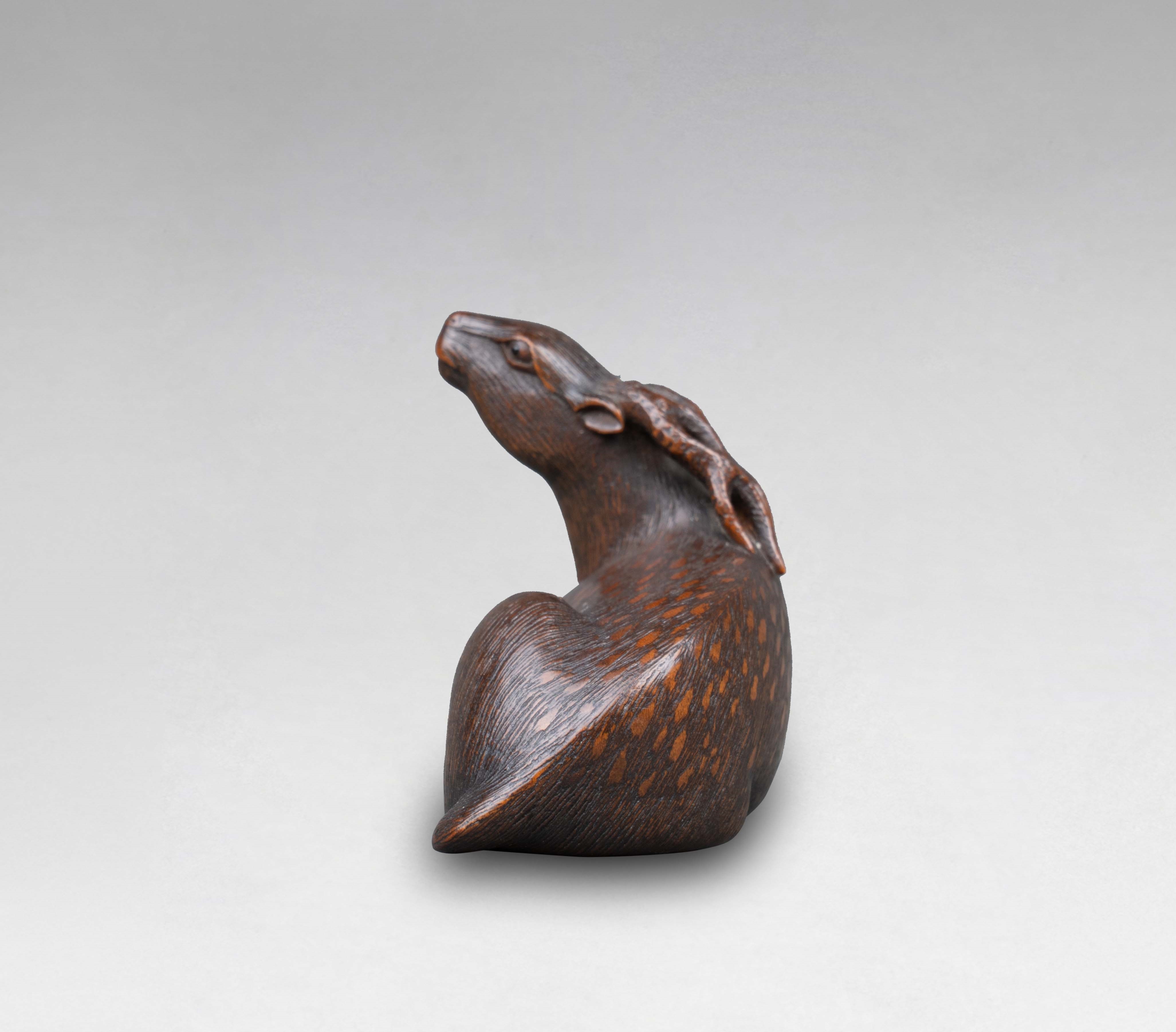
Netsuke – Rare modèle d’un ravissant daim en bois sculpté, représenté couché, la tête légèrement relevée, ses pattes rentrées sous son ventre dans une attitude très gracieuse. Ses bois retombant le long de son cou et du dos de l’animal. Ravissant pelage aux tâches reconnaissables. Belle finesse de sculpture pour un modèle de belle taille. Hauteur : 3,4 x longueur : 4 cm. Japon Edo (1603-1868) 19e siècle.
Netsuke – Rare and very fine model of a reclining deer, carved, lying, with the head slightly raised, the staghorns falling down its back and its legs folded beneath, the hairwork is well carved and easily recognizable. Beautiful details of sculpture for a good size. Hight : 3.4 x Length 4 cm. Japan Edo (1603-1868) 19th century.
Netsuke – Cachet avec scène de village sous des pins
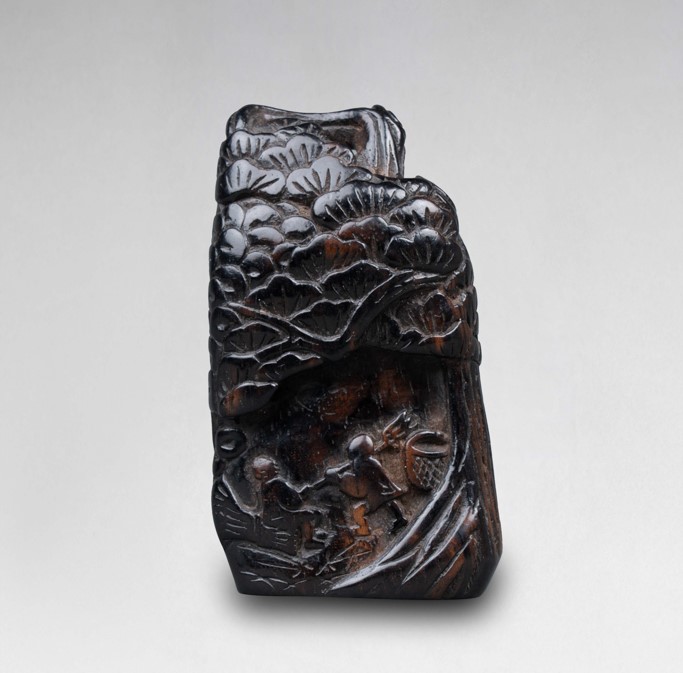
Netsuke – Belle forme inhabituelle pour un modèle de bonne dimension, représentant une petite scène de village sous des pins. En bois de kurokaki ou kokutan, qui s’apparente au plaqueminier. Il porte une date au dos (1838). Porte le cachet Sei. Hauteur : 6,4 cm. Japon Edo (1603-1868) 19e siècle.
Netsuke – A lovely and unusual big shape for this model of a village scene, with pine trees. Kurokaki or kokutan wood. A date of 1838 on the back and a signature of Sei under the base. Hight : 6,4 cm. Japan Edo (1603-1868) 19th century.
Netsuke – Ryusa Manju à décor de shishi
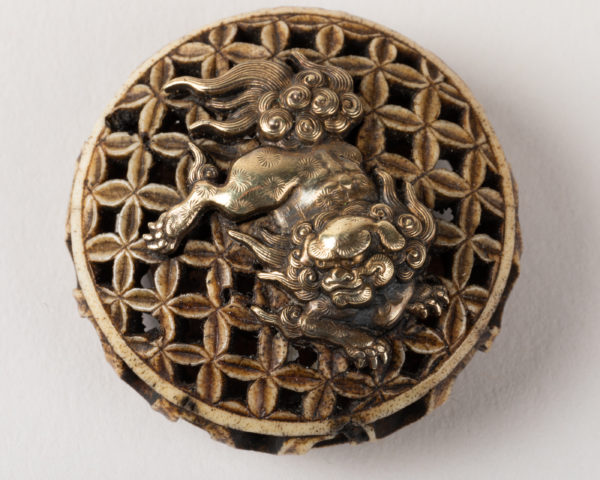
Ravissant modèle de Netsuke en corne de cerf. Manju ajouré – Ryusa Manju, avec une plaque représentant un shishi en cuivre doré sur un fond motifs géométriques en croisillons – shippo. Il s’agit d’un Kagamibuta. Un seul himotoshi central en forme d’hanabashi au revers. Belle finesse de sculpture. Japon, Edo, (1603-1868), fin du 18e, début du 19e siècle. Ecole d’Asakusa.
A good and well-detailed stag horn model of a pierced and hollowed-out Ryusa Manju applied with solid a gold copper shishi on a background with a geometric shippo pattern. Kagamibuta. Single round himotoshi of an hanabashi-motif on the reverse. Japan Edo (1603-1868) end of 18th, early 19th century. Asakusa carver.
Karako soulevant le sac de Hotei, par Masakiyo

Netsuke par Masakiyo- Très joli modèle en bois sculpté représentant un Karako (enfant chinois) agenouillé, essayant de toutes ses forces, de soulever le sac de Hotei. Ravissants détails sculpté. Japon Meiji (1868-1912) fin du 19e, début du 20e siècle. Hauteur : 2,9 x 3,3 cm. Signé sous la base : Masakiyo jeune (lignée de Masanao).
Netsuke by Masakiyo – A good wood netsuke of a Karako (chinese child) wearing festive robes with trying to lift Hotei’s large bag. Very fine details. Japan Meiji (1868-1912) end of 19th, early 20th century. Dimensions : 2,9 x 3,3 cm. Signed under the base ; Masakiyo young (branch of Masanao)
Netsuke – Shichifukujin Takarabune, le bateau des 7 dieux du bonheur
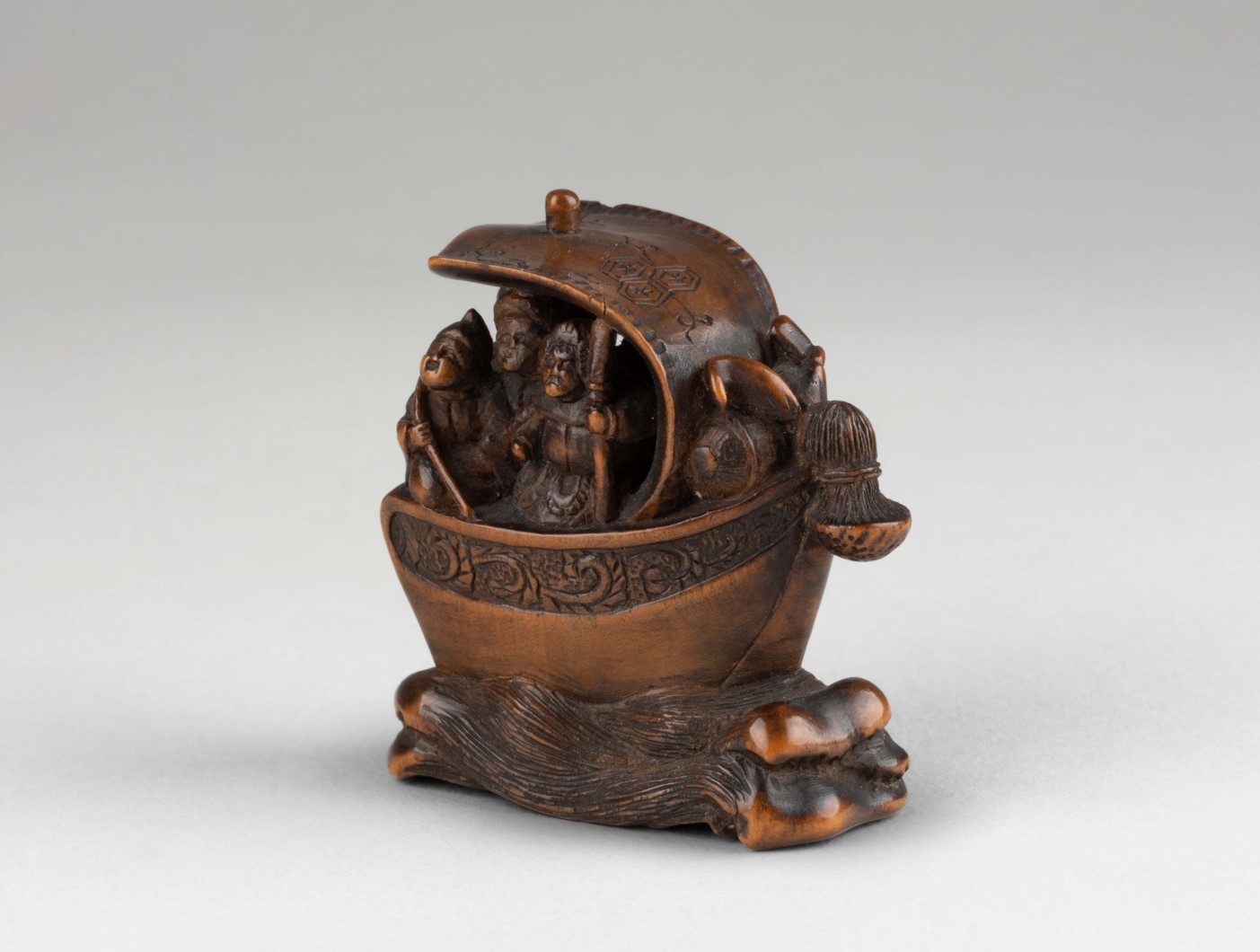
Netsuke – Joli modèle du Shichifukujin Takarabune (Le célèbre bateau chargé de trésors des 7 dieux du bonheur) en buis sculpté. Jolis détails de sculpture de l’ensemble de la composition. Les 7 divinités sont toutes identifiables, le bateau lui-même est orné, les flots et une petite tortue Minogame sculptés sur la base. La signature en cartouche a disparu avec le temps. Très belle patine naturelle. Hauteur : 3,5 cm. Japon Edo (1603-1868) 19e siècle.
Netsuke – A good boxwood model of the Shichifukujin takarabune (Seven gods of good fortune in the famous treasure boat). Very fine details of sculpture, with the 7 gods that can be identified, the boat with beautiful patterns and carved with the waves and a Minogame on the base. Signed but the signature, as a reserve, has gone. H : 3,5 cm. Japan Edo (1603-1868) 19th century.
Netsuke – Renard déguisé représenté assis
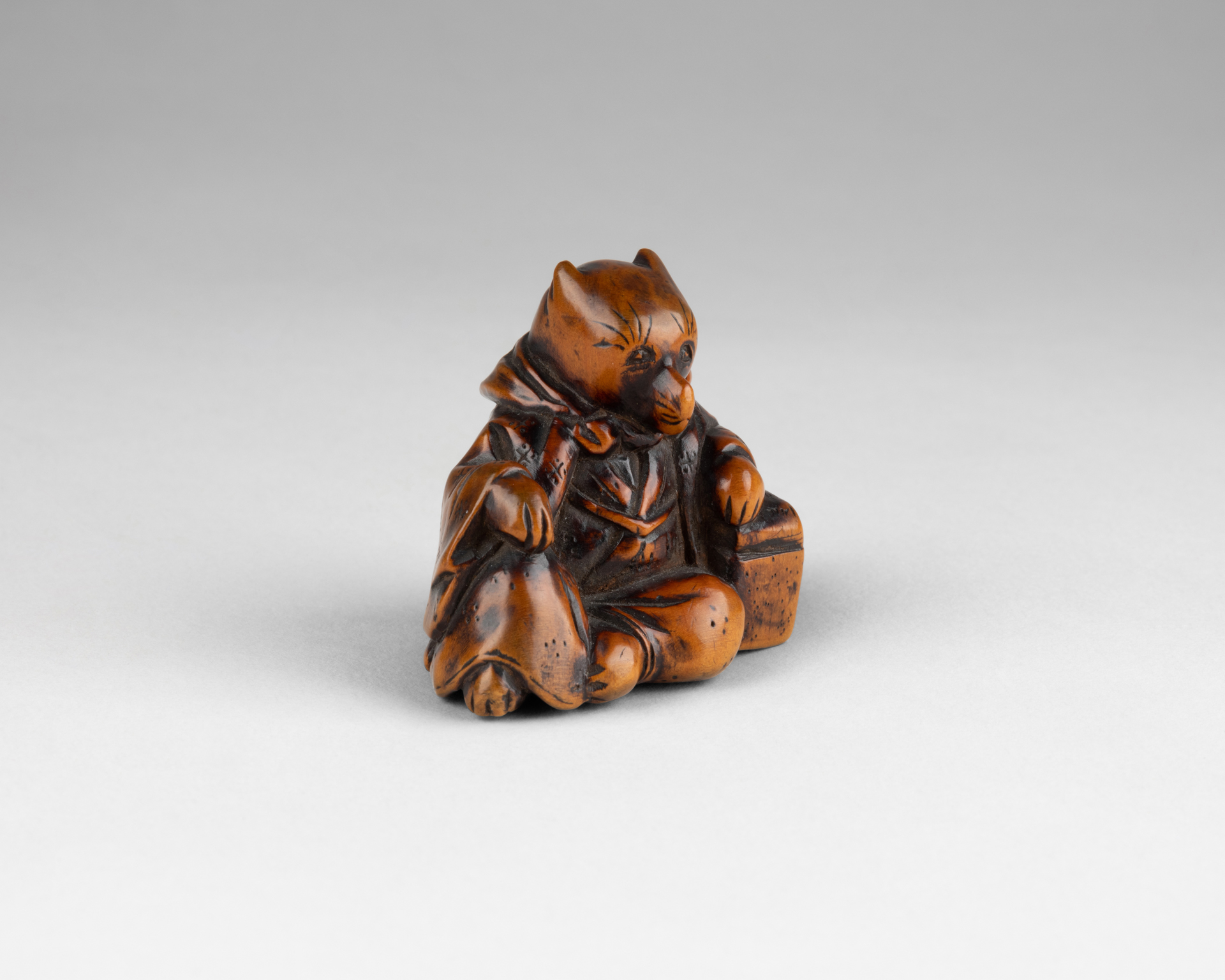
Netsuke – Joli modèle représentant un renard, en japonais Kitsune, en bois sculpté, représenté assis, vêtu d’un long manteau, déguisé en prêtre, accoudé sur un socle sur lequel repose un livre ouvert. Joli modèle avec une belle patine naturelle. Himotoshi dans le dos. Dimensions : 4 x 3,7 cm. Japon Edo (1603-1868) fin du XVIIIe siècle.
Netsuke – A good model of a fox (Kitsune in Japan) seated, dressed as with a long coat, disguised as a priest, leaning on a pedestal on which rests a book open. Beautiful natural patina. Himotoshi on the back. Dimensions : 4 x 3,7 cm. Japan Edo (1603-1868) end of 18th century.
Sishimaï par Sukeyuki

Netsuke – Ravissant modèle en bois sculpté par Sukeyuki représentant un danseur de Shishimaï. Danseur représenté assis avec seulement des jambes visibles sous son large manteau et son masque de lion. Signé sous la base. Japon Edo (1603-1868) XIXe siècle
Netsuke – A wooden model by Sukeyuki of a shishimai performer The dancer is seated with only his legs visible below his cloak and lion mask. Signed under the base. Japan Edo (1603-1868) 19th century
Netsuke – Acteur de théâtre
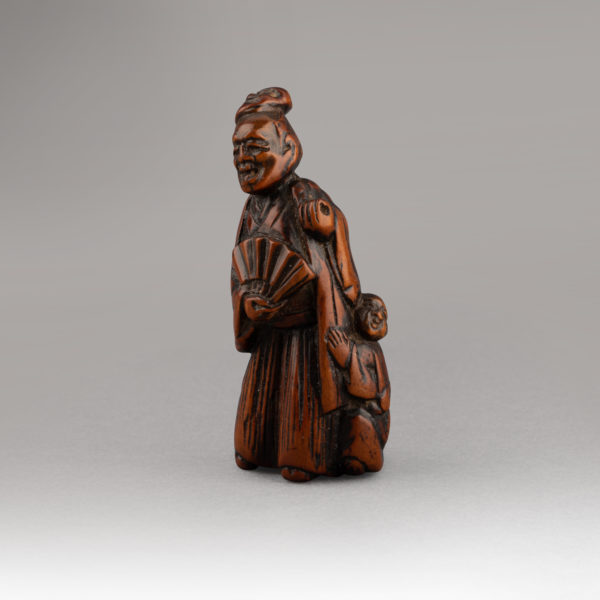
Netsuke – Joli sujet en buis sculpté, représentant un groupe d’un acteur de théâtre qui se tient debout, avec à ses côtés un enfant. Il porte un large et riche vêtement, un éventail et un masque. Jolis himotoshi à l’arrière, belle patine naturelle du bois. Sujet peu fréquent. Japon Edo (1603-1868) fin du XVIIIe, début du XIXe siècle,
Netsuke – A nice and attractive group of a tragic actor standing with a young boy by his side, he wers a beautiful and large robe and holds a fan and a mask. Beautiful patina with large himotoshi. Unusual subject. Japan Edo (1603-1868), end of 18th, early 19th century.
Netsuke – Châtaignes sur un sac
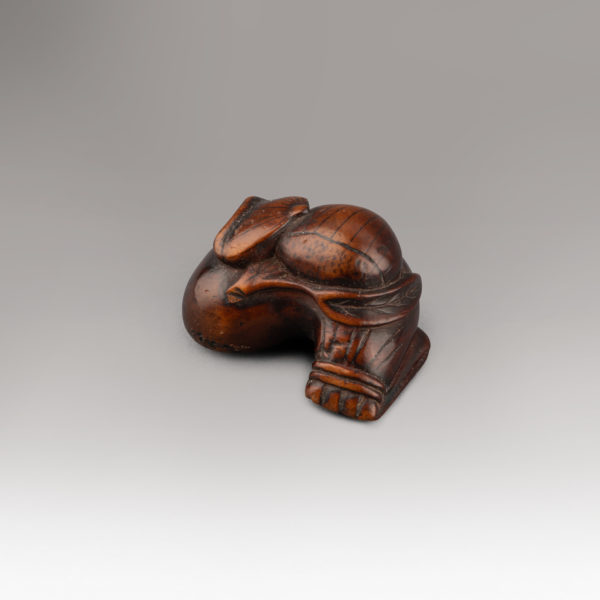
Netsuke – Ravissant modèle au sujet très simple et poétique, en buis sculpté, représentant des châtaignes posées sur un sac. Jolie patine naturelle du bois. Japon Edo (1603-1868) XVIIIe siècle
Netsuke – A good and fine wood carved model of a beautiful and poetic subject, representing chestnuts on a small bag. Beautiful and natural patina. Japan Edo (1603-1868) 18th century.
Netsuke – Groupe de châtaignes en bois sculpté
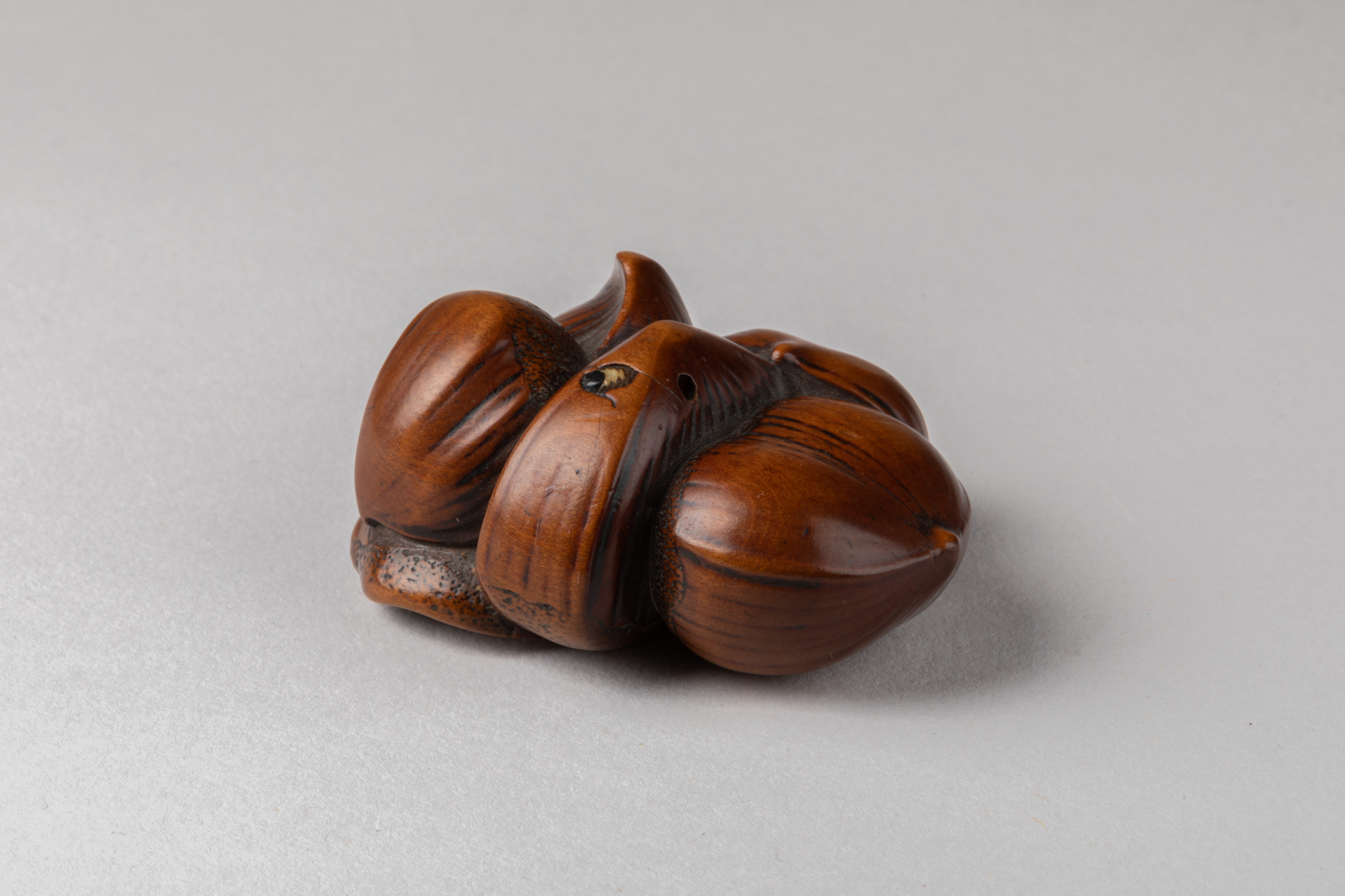
Netsuke – Charmant modèle d’un groupe de plusieurs châtaignes accolées en buis sculpté, dont l’une d’elles laisse apercevoir le passage d’un petit ver, en os sculpté. La couleur naturelle de la châtaigne et l’usure du bois offre une représentation très naturaliste. Larges himotoshi à l’arrière. Belle patine naturelle. Jolie finesse de sculpture. Probablement ancienne collection Carlo Monzino, n°191 vendu chez Sothebys Londres en 1995. Dimensions : 5 cm Epoque Edo fin du XVIIIe siècle
Netsuke – A lovely model of boxwood group of chestnuts with a small worm passing through a hole of one of them. The colour and makings of the wood used to fullest advantage to give a very realistic looking appearance. Finely carved with delicate work and a beautiful natural patina. Probably the old collection Carlo Monzino, n°191 sold at Sotheby’s London in 1995. Edo era, end of 18th century
Netsuke – Joli modèle d’un crapaud sur une sandale – Masanao
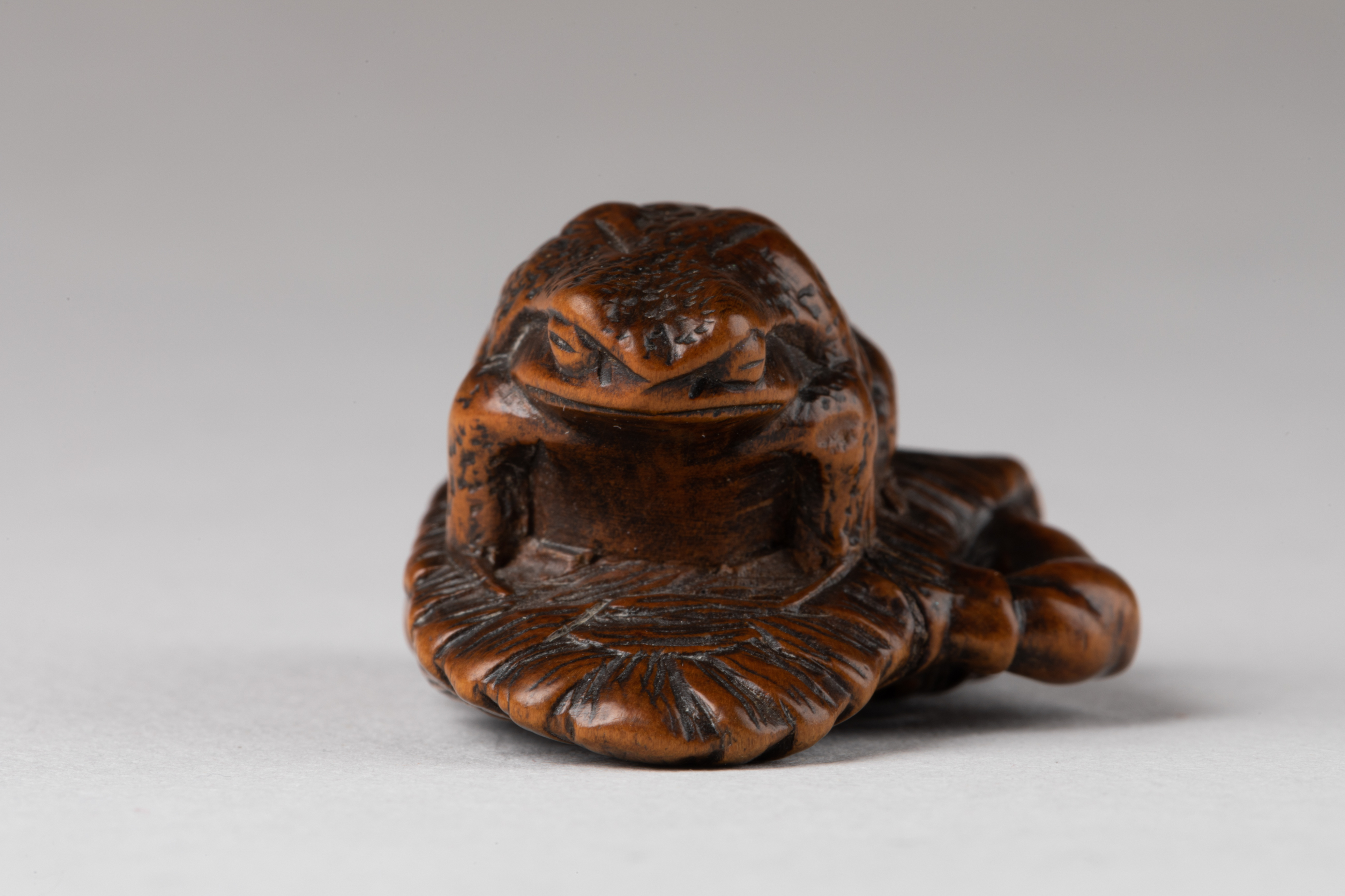
Netsuke – Joli petit modèle en bois sculpté d’un crapaud, assis sur une Waraji abandonnée (sandale en paille), ses pattes arrières fléchies et sa tête légèrement relevée alors qu’il se prépare à sauter, la lanière de la sandale forme l’Himotoshi. Belle patine naturelle teintée de noir. Signé sous la base sur une réserve : Masanao (de Yamada). Longueur : 3,2 cm. Japon Edo (1603-1868) XIXe siècle.
Netsuke – A wood modele of a toad, seated on a discarded Waraji (straw sandal), its hind leg flexed and its head raised as it prepares to leap, the thong of the sandal forming the Himotoshi. Beautiful and natural patina, the wood dark-stained. Signed under the base on a reserve : Masanao (of Yamada). Lentgh : 3,2 cm. Japan Edo (1603-1868) 19th century.
Netsuke – Coquillages accolés
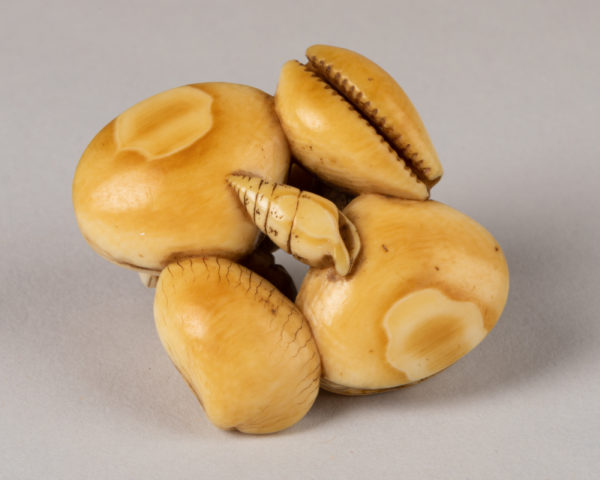
Netsuke – Joli modèle en ivoire finement sculpté, représentant un groupe de différents coquillages accolés. Japon Edo (1603-1868) début du XIXe siècle. Longueur : 4,4 cm. Belle patine naturelle couleur miel. CIC n°2207511937-K.
Netsuke – A finely carved ivory netsuke of a cluster of various shells, some of them with an inner life reminiscent of the famous clam’s dream story. The himotoshi underneath is formed by one of the trumpet shells. Beautiful patina. Length : 4.4 cm. Japan Edo (1603-1868) Early 19th century. CIC n°2207511937-K
Prix sur demande – Price on request
Conformément à la nouvelle règlementation européenne mise en application au 18 janvier 2022, le commerce de l’ivoire est désormais soumis à l’obtention d’un certificat CIC (demande en cours). Son exportation hors de l’union européenne est interdite.
Champignon et châtaigne
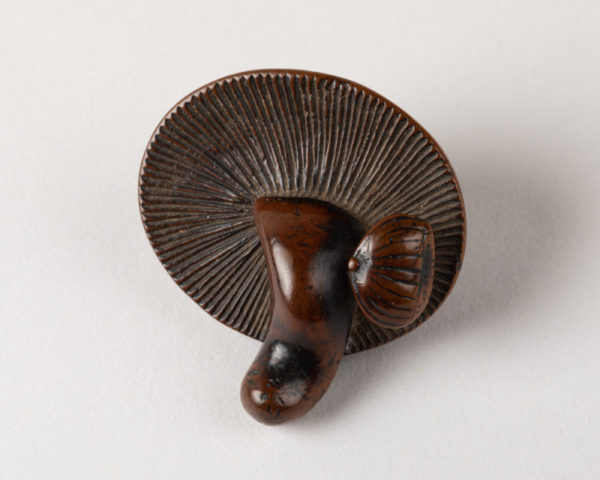
Netsuke – Ravissant sujet d’automne pour ce netsuke en bois sculpté représentant un groupe formé par un champignon dont le chapeau repose sur le sol et une petite châtaigne accolée. Jolie patine naturelle du bois. 4x 4,5 cm. Japon Edo (1603-1868) XIXe siècle.
A wood chestnut rest on the underside of a plump mushroom. Nice natural patina. 4 x 4,5 cm. Japan Edo (1603-1868) 19th century.
NETSUKE – Chiot couché sur un tapis
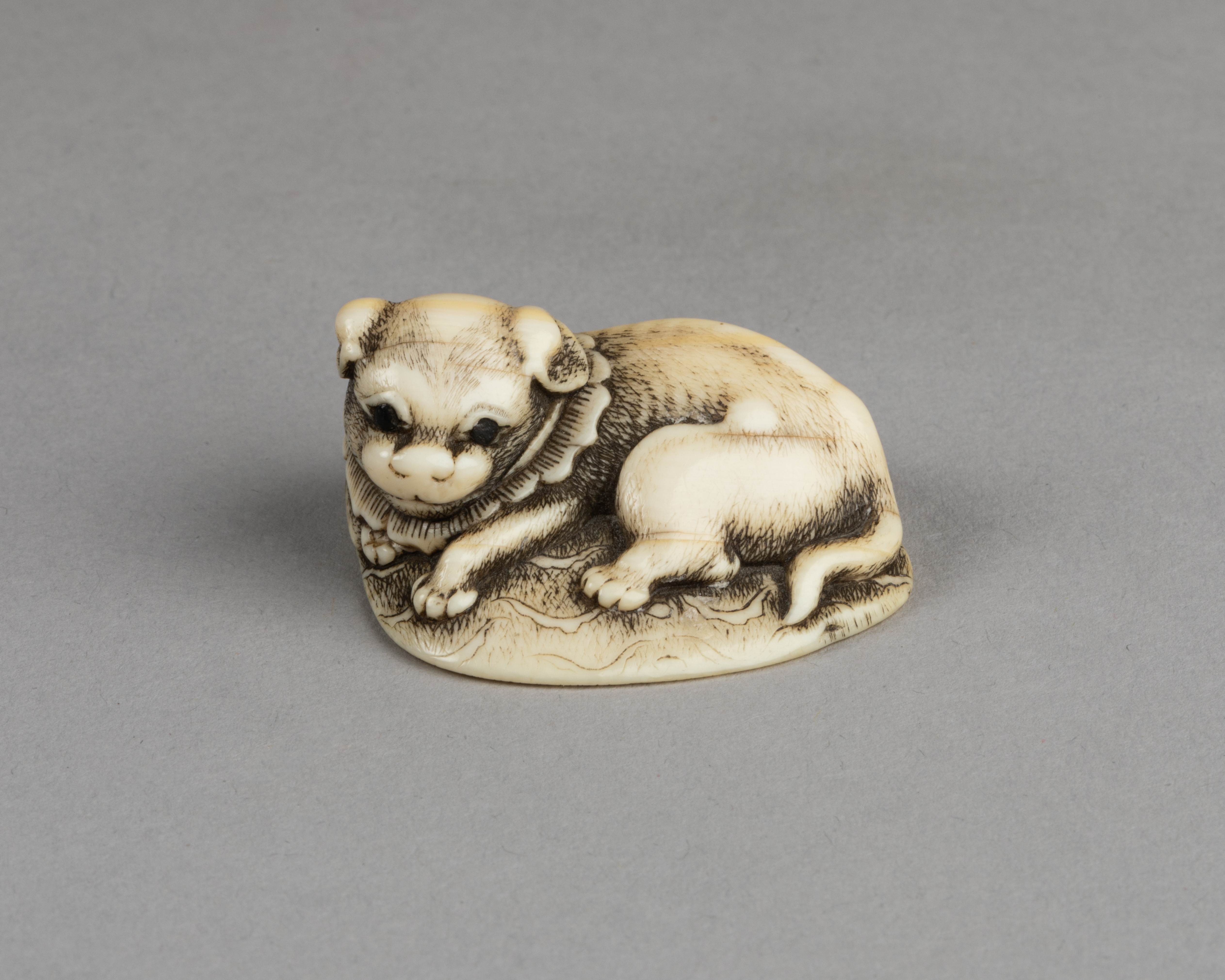
Netsuke – Ravissant modèle en ivoire, représentant un chiot couché sur un tapis, portant une petite collerette. Les yeux sont incrustés de corne brune. Très belle patine naturelle. Longueur : 3,8 cm. Japon Edo (1603 – 1868) fin XVIIIe, début du XIXe siècle. CIC n°FR2207511938K
Netsuke – Attractive and lovely model carved from ivory. A puppy lying on the carpet, with a decorated collar around its neck, and inlaid with a brown horn in its eyes. Beautiful patina on the fur. Length : 3,8 cm. Japan Edo (1603 – 1868) end of 18th, very early 19th century. CIC n°FR2207511938K
Prix sur demande – Price on request
Conformément à la nouvelle règlementation européenne mise en application au 18 janvier 2022, le commerce de l’ivoire est désormais soumis à l’obtention d’un certificat CIC. Son exportation hors de l’union européenne est interdite.








































